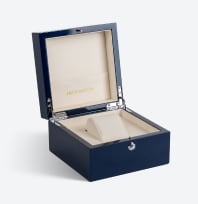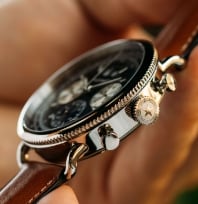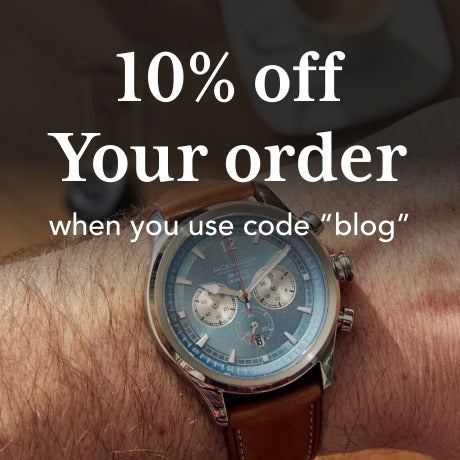The fit of a watch can make or break a man. There are many situations one could run into if your watch band does not fit securely on your wrist. Consider a situation where you are attending a fancy party. You are wearing a custom-tailored fitted suit, but your watch band is too large hiding your beautiful, luxury timepiece under your french cuff. Or you have extensively planned a guys weekend trekking through the Moab desert and camping on a rock face when your watch band gets caught on a rock while rappelling down a cliff, a spring pin breaks, and you watch your favorite field watch fall to its death. Or in an everyday situation, what if your watch is too tight and is cutting off your circulation to your hand during an important board meeting and you fidget the whole time looking unprofessional.
These situations may seem extreme, but they are based on reality. The reality is, you need to protect your timepiece investment so it can withstand the test of time.
Making sure your watch band fits your wrist is essential to your watch's durability and looking put together at the same time. It is incredibly easy to measure your own wrist to make sure you have the perfect fit for any band type and any situation, whether it be style, practicality, or adventure.
Measuring Prep
In this little DIY, you will need to measure your wrist as the baseline so you can figure out your size in each of the three variations of straps. All straps are not created the same and sit very differently on the wrist, but we'll break all that down.
Three main types of straps or bands:
The easiest way to measure your wrist size is with a flexible measuring tape, called seamstress or a tailor's measuring tape. These are available in the sewing section of most big box stores or available for sale online. If you don't have access to a tailor's tape, the best way to improvise is with a narrow piece of paper or a string and a standard ruler.
Most watch strap measurements are given in millimeters, so for these purposes, we will use the centimeter side of our measuring tape or ruler to make our measurements.
A couple of things to keep in mind while measuring your wrist.
- Your wrist is going to be a little larger at the end of the day as opposed to the beginning as your body retains water throughout the day.
- Your wrist is going to be slightly larger when your hand and palm are open as the wrist bone adjusts when you make this movement.
- You will need to take into account your preference when it comes to where you like to wear your watch on your wrist and measure that section accordingly. For our purposes, we are going to take our measurements in the middle and on the bone.
- Above the bone
- On the bone
-
Below the bone
4. Lastly, you'll need to consider which type of band you'll be wearing your watch with. The correct measurement of your strap will vary depending on which style of band you will be wearing.
- Metal Bracelet or Band
- Leather Strap or Band
- NATO Strap
How to Measure Your Wrist Properly
With your palm open and the underside of your wrist facing up, take your tailor's tape, place the end with the metal tip in the center of your wrist, and pull the tape over your wrist till it fits snug. Line up the tip of the metal with the measurement that sits the closest to the tape. You may find it most comfortable to go ahead and loop the tape, slide it over your wrist and then pull the tape snuggly down to the metal tip. Write this measurement down in centimeters. To calculate millimeters, there are 10 millimeters in a centimeter. 10 times the number of centimeters plus the number of millimeters over the last centimeter in your measurement equals your wrist measurement in centimeters.
10 x # of cm + # of mm over last cm = wrist measurement in cm.
Alternative Measuring Technique
If you do not have a tailor's tape, your piece of paper or string can function pretty much the same way. Wrap the paper or string around your wrist and mark with a pen or marker where the two pieces overlap. Then take your piece of paper or string and measure mark to mark on your ruler.
- Place underside of wrist face up.
- Open up your palm to widen your wrist.
- Place the metal end of tailor's tape in the center of your wrist.
- Pull the tape over your wrist to where it fits snug.
- Line up the tape with the metal end piece and read the measurement in centimeters.
- A quick Google conversion for the millimeters
This measurement takes into account the rough size of your wrist with your watch face, but some minor adjustments are needed.
Wrist Size Into Watch Band Size
Now that you know the size of your wrist, it is time to translate it into your watch band size. I've chosen the three main different types of watch bands, as these bands are all worn with different tightnesses in mind.
Metal Bracelet or Band
Metal bands are the most fluid of the bands and are typically worn a little looser to provide ease of movement throughout the day. We offer an extensive collection of metal bands at Jack Mason--take a look at our full stock of metal bracelet watches! The rule of thumb that will give you enough slack in your metal bracelet is that the bracelet plus the watch face should be one centimeter larger than your wrist measurement. Highest rated Jack Mason Metal Bracelet Watch is our Seatrek with its Black Dial and Stainless Steel Bracelet.
You can take this measurement of a watch and metal bracelet you already own by wrapping the measuring tape similar to how you measured your wrist and inside the closed band. This should give you a pretty accurate reading of the measurement of your metal bracelet, and you'll then know if you need to add or remove a link to provide you with maximum comfort.
Leather Band
A leather band has the least amount of give and, in fact, can be stiffer if it is brand new leather. There will be two forms of measuring the strap to know if a leather strap will fit your wrist.
- Is the strap already installed on your watch?
- Are you shopping for straps and have yet to install it.
If your strap has already been installed on your watch face, then it is gravy from there. Simply measure from the end of the buckle all the way down the watch. The rule of thumb on a leather watch that fits snug and gives you a little movement is that the leather band should be almost two centimeters longer than your wrist measurement.
If your strap is not installed on your watch face, you are going to need to measure your watch face and add in that measurement. Hold your watch face on its side and measure from one spring pinhole to the other. This is the measurement of the face of your watch.
Now measure the short strap of your watch from the bottom of the buckle to the spring pinhole. Measure the long end of the strap from the spring pinhole to the second or third hole on the watch band. Add the three measurements together. The same rule of thumb applies: there should be a two-centimeter difference from the watch measurement to your wrist measurement for a good snug fit with barely enough room for movement.
NATO Strap or Band
Measuring for the NATO strap is relatively straightforward due to its single piece of material construction. However, your watch's face sits up slightly from the back of your wrist due to the iconic design of the NATO strap. The extra material of the two sections of your strap that your watch face is threaded through must be taken into account. The rule of thumb with a NATO strap is that it should come out to be a full inch or 2.5 centimeters larger than your wrist measurement to account for this rise in the watch face.
Simply add 2.5 centimeters to your wrist measurement and lay your NATO strap flat, try out our highly rated Black Nylon NATO strap for something durable and ageless. Measure from the bottom of the buckle, and across to the other side of the long side of the strap is about 5 centimeters longer than your wrist measurement, you are good to go. With a classic NATO strap, the material on the other side of the watch face is usually fairly long so it can be threaded back and through the rings. However, some contemporary straps have buckle holes just like a leather strap, so there again, you will want your measurement to reach the second or third buckle hole to be comfortable.
That wasn't so bad, right? You didn't have to McGyver your way through it, and now you can walk into the watch section and be confident that you know the size and needs of your next watch strap or band purchase. You are well on your way to being an avid watch collector!
Sources:
https://www.realmenrealstyle.com/watch-size












